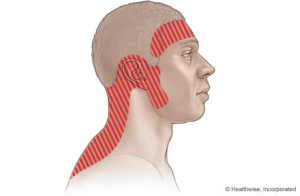Tension headache or tension-type headache (TTH) is the most common primary headache disorder. It happens intermittently in up to 80% of the population. This headache is described as pressure or tightness, often like a band around the head, sometimes spreading into or from the neck (World Health Organization [WHO], 2016).

TTH often begins during the teenage years, affecting 3 women to every 2 men. Its mechanism may be stress-related or associated with musculoskeletal problems in the neck. Episodic TTH attacks usually last a few hours, but can persist for several days. Chronic TTH can be unremitting and is much more disabling that episodic TTH (WHO, 2016).
Frequent TTH is recognized when the sufferer has experienced at least 10 headaches in a one-month period. There are varying degrees of frequency and chronicity.
Chronic Tension Headache sufferers report headaches on more than 180 days in a year. Tension Headache pain tends to be bilateral, and pressing or tightening in nature. It is of mild to moderate intensity and will not tend to interrupt work.
Tension Headache sufferers can experience symptoms associated with migraine such as nausea and photophobia (hypersensitive to light) phonophobia (hypersensitive to sound), but usually only one of these symptoms.
There is no one specific test that identifies a tension type headache. Your diagnosis will be made based on your health professional’s interpretation of your symptoms and how you respond to different treatments
Unfortunately X-rays, CT-scans and MRI’s are not diagnostic of a tension headache. You can suffer a tension type headache with or without some abnormal findings on X-rays or scans. Likewise, scan abnormalities do not guarantee that you will experience a tension headache. However, X-rays and scans may identify structures that could potentially be causing your tension type headache. We recommend that you have at least cervical spine X-rays if you have been suffering headaches or head pain for any extended period.
Quality neck physiotherapy or massage can have a very quick and effective result for relieving your tension headache through relaxation of muscles under excessive tension. It is also important to remember that excessive muscle tension will compress, distort or irritate joint structures that cause neck headache, which will further complicate your symptoms.
Your tension type headache treatment may include all or some of the following techniques:
- Stiff neck joints may need to be loosened or unlocked via joint mobilisation (gentle gliding techniques), joint traction or in specific cases a gentle and localised joint manipulation technique.
- Hypermobile (or dynamically unstable) joints may require specific deep neck muscle strengthening exercises to stabilise, control and limit the joint movement available.
- Tight or overactive muscles may require stretching, massage, acupuncture, dry needling, or other relaxation techniques.
- Weak muscles may require specific strengthening exercises. This may include your postural shoulder blade and neck muscles.
- Nerve dysfunction may be addressed by your physiotherapist depending upon your specific examination findings. Neurosensitivity is a common finding that needs to addressed with cautious professional care and attention.
- Posture correction may be recommended via specific exercises, posture awareness techniques, taping or a posture brace.
- Helpful advice on how to prevent neck dysfunction in the future eg awkward neck positions and postures to avoid.
References
Brukner & Kahn. 2014. Clinical sports medicince, 4th edition.
World Health Organization. 2016. Headache disorders. Retrieved from: http://www.who.int/mediacentre/factsheets/fs277/en/


